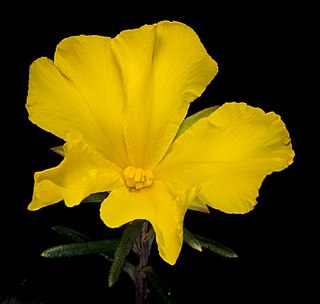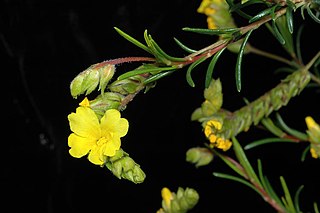Hibbertia abyssus, commonly known as Bandalup buttercup, is a species of flowering plant in the family Dilleniaceae and is endemic to a restricted area of Western Australia. It is an erect shrub with linear to tapering leaves and yellow flowers arranged singly in leaf axils with the five stamens all on one side of the carpels.
Hibbertia acrotrichion is a species of flowering plant in the family Dilleniaceae and is endemic to a restricted area of Western Australia. It is a small, erect shrub with linear, cylindrical leaves and yellow flowers arranged singly in leaf axils with eleven stamens arranged in groups.
Hibbertia atrichosepala is a species of flowering plant in the family Dilleniaceae and is endemic to a restricted area in the south-west of Western Australia. It is an upright shrub with crowded linear to tapering leaves and yellow flowers arranged singly in leaf axils with glabrous sepals and the five stamens all on one side of the two carpels.
Hibbertia ferruginea is a species of flowering plant in the family Dilleniaceae and is endemic to the south-west of Western Australia. It is an erect or spreading shrub with linear, sessile leaves and yellow flowers borne in leaf axils near the ends of branchlets with fifteen stamens in five groups surrounding the five carpels.
Hibbertia cockertoniana is a species of flowering plant in the family Dilleniaceae and is endemic to the south-west of Western Australia. It is an erect shrub with scattered linear leaves and yellow flowers arranged singly in leaf axils usually with ten stamens all on one side of the two carpels.
Hibbertia depilipes is a species of flowering plant in the family Dilleniaceae and is endemic to the far south-west of Western Australia. It is usually a sprawling shrub with scattered linear leaves and yellow flowers arranged singly in leaf axils usually with ten stamens all on one side of the two carpels.

Hibbertia fasciculiflora is a species of flowering plant in the family Dilleniaceae and is endemic to the south-west of Western Australia. It is an erect to spreading shrub with linear to narrow oblong leaves arranged in dense bunches near the ends of branchlets, and yellow flowers borne among the leaf bundles with eight to ten stamens all on one side of the two carpels.
Hibbertia glabrisepala is a species of flowering plant in the family Dilleniaceae and is endemic to the south-west of Western Australia. It is an erect to sprawling shrub with linear to narrow oblong leaves and bright yellow flowers borne on the ends of short side shoots, with fifteen stamens in groups surrounding the five carpels.
Hibbertia hooglandii is a species of flowering plant in the family Dilleniaceae and is endemic to the Kimberley region of Western Australia. It is a small, erect or spreading, multi-stemmed shrub with linear leaves and golden yellow flowers arranged singly in leaf axils, with seventeen to twenty-five stamens, all on one side of two densely hairy carpels.

Hibbertia huegelii is a species of flowering plant in the family Dilleniaceae and is endemic to the south-west of Western Australia. It is an erect, spreading or prostrate shrub with hairy branchlets, linear leaves and yellow flowers arranged singly in leaf axils on the ends of shoots, with fifteen to twenty-five stamens in bundles around the four or five carpels.

Hibbertia leptopus is a species of flowering plant in the family Dilleniaceae and is endemic to Western Australia. It is an erect shrub with linear leaves and yellow flowers, usually with eleven stamens arranged around the three carpels.

Hibbertia leucocrossa is a species of flowering plant in the family Dilleniaceae and is endemic to the south-west of Western Australia. It is a spreading to more or less erect shrub with narrow egg-shaped leaves and yellow flowers, with 15 to 21 stamens arranged in bundles around the three carpels.

Hibbertia lineata is a species of flowering plant in the family Dilleniaceae and is endemic to the south-west of Western Australia. It is a spreading to erect shrub with linear to narrow egg-shaped leaves and yellow flowers, usually with ten stamens arranged on one side of, and leaning over the two densely hairy carpels.
Hibbertia notibractea is a species of flowering plant in the family Dilleniaceae and is endemic to the south-west of Western Australia. It is an erect, sprawling or prostrate shrub with linear to narrow elliptic leaves and yellow flowers with eleven stamens, nine in groups of three, arranged around three glabrous carpels.
Hibbertia papillata is a species of flowering plant in the family Dilleniaceae and is endemic to the Fitzgerald River National Park in Western Australia. It is an erect shrub with crowded, linear, hairy leaves and yellow flowers usually with ten stamens, all on one side of, and curving over two hairy carpels.
Hibbertia priceana is a species of flowering plant in the family Dilleniaceae and is endemic to the south-west of Western Australia. It is a dwarf, usually compact shrub with erect, narrow elliptic leaves and bright yellow flowers with eleven stamens, nine in three groups of three, around three glabrous carpels.
Hibbertia propinqua is a species of flowering plant in the family Dilleniaceae and is endemic to a restricted area in the west of Western Australia. It is an erect to spreading shrub with linear to narrow oblong leaves and yellow flowers arranged amongst clusters of leaves, the flowers with eight to ten stamens all on one side of the two carpels.

Hibbertia robur is a species of flowering plant in the family Dilleniaceae and is endemic to the west of Western Australia. It is a strongly erect shrub with linear leaves and a few yellow flowers arranged singly at the ends of branchlets, the flowers with eight to eleven stamens all on one side of the two carpels.
Hibbertia sericosepala is a species of flowering plant in the family Dilleniaceae and is endemic to the west of Western Australia. It is an often sprawling shrub with clustered, linear leaves and yellow flowers surrounded by leaf clusters, the flowers with twenty-five to thirty stamens in five bundles around the three carpels.

Hibbertia spicata is a species of flowering plant in the family Dilleniaceae and is endemic to the west of Western Australia. It is a low, erect to spreading shrub with scattered linear leaves with the edges rolled under and yellow flowers with six or seven stamens on one side of two softly-hairy carpels, and a larger number of staminodes.






